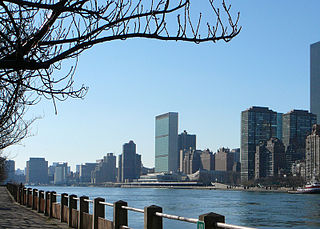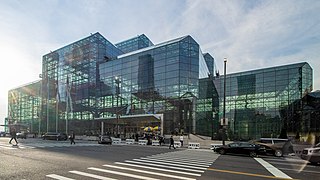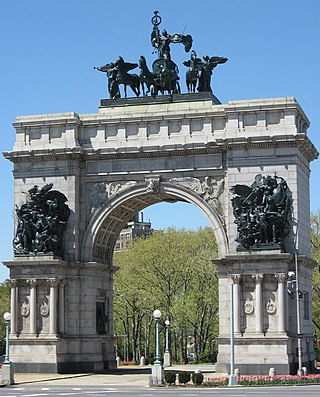
The East River is a saltwater tidal estuary or strait in New York City. The waterway, which is not a river despite its name, connects Upper New York Bay on its south end to Long Island Sound on its north end. It separates Long Island, with the boroughs of Brooklyn and Queens, from Manhattan Island, and from the Bronx on the North American mainland.

A green roof or living roof is a roof of a building that is partially or completely covered with vegetation and a growing medium, planted over a waterproofing membrane. It may also include additional layers such as a root barrier and drainage and irrigation systems. Container gardens on roofs, where plants are maintained in pots, are not generally considered to be true green roofs, although this is debated. Rooftop ponds are another form of green roofs which are used to treat greywater. Vegetation, soil, drainage layer, roof barrier and irrigation system constitute the green roof.

A roof garden is a garden on the roof of a building. Besides the decorative benefit, roof plantings may provide food, temperature control, hydrological benefits, architectural enhancement, habitats or corridors for wildlife, recreational opportunities, and in large scale it may even have ecological benefits. The practice of cultivating food on the rooftop of buildings is sometimes referred to as rooftop farming. Rooftop farming is usually done using green roof, hydroponics, aeroponics or air-dynaponics systems or container gardens.

Urban agriculture refers to various practices of cultivating, processing, and distributing food in urban areas. The term also applies to the area activities of animal husbandry, aquaculture, beekeeping, and horticulture in an urban context. Urban agriculture is distinguished from peri-urban agriculture, which takes place in rural areas at the edge of suburbs.

Fort Greene is a neighborhood in the northwestern part of the New York City borough of Brooklyn. The neighborhood is bounded by Flushing Avenue and the Brooklyn Navy Yard to the north, Flatbush Avenue Extension and Downtown Brooklyn to the west, Atlantic Avenue and Prospect Heights to the south, and Vanderbilt Avenue and Clinton Hill to the east. The Fort Greene Historic District is listed on the New York State Registry and on the National Register of Historic Places, and is a New York City designated historic district.

The Jacob K. Javits Convention Center, commonly known as the Javits Center, is a large convention center on Eleventh Avenue between 34th Street and 38th Street in Hell's Kitchen, Manhattan, New York City. It was designed by architect James Ingo Freed of Pei Cobb Freed & Partners. The space frame structure was constructed from 1979 to 1986 and was named to honor Jacob Javits, the United States Senator for New York. When the Javits Center opened, it replaced the New York Coliseum at Columbus Circle as the city's major convention facility; the Coliseum was subsequently demolished and replaced by Time Warner Center.

Riverbank State Park is a 28-acre (11 ha) state park built on top of a sewage treatment facility on the Hudson River, in the New York City borough of Manhattan. It was opened in 1993. On September 5, 2017, it was renamed Denny Farrell Riverbank State Park, after longtime New York State Assembly member Denny Farrell who represented the surrounding area.

Sustainable drainage systems are a collection of water management practices that aim to align modern drainage systems with natural water processes and are part of a larger green infrastructure strategy. SuDS efforts make urban drainage systems more compatible with components of the natural water cycle such as storm surge overflows, soil percolation, and bio-filtration. These efforts hope to mitigate the effect human development has had or may have on the natural water cycle, particularly surface runoff and water pollution trends.
Rooftop Films is a non-profit film organization based in Gowanus, Brooklyn. It is best known for its Rooftop Films Summer Series, a film festival that runs from May through August every year, and consists of as many as 47 outdoor screenings of new independent short and feature-length films. Rooftop screenings all take place on rooftops or in other outdoor locations throughout New York City. Rooftop also offers film and video equipment rentals throughout the year, as well as grants which help finance new independent film projects.

In New York City, there is an extensive water supply system that supports several programs and infrastructure pertaining to the city's food supply. City officials, agencies, and organizations cooperate with rural farmers to grow food more locally, as well as protect waterways in the New York metropolitan area. The New York City Department of Education operates a school-time and summertime breakfast/lunch program. The city is also deprived of supermarkets in several neighborhoods, and the city government has addressed the problem by allowing extra street vendors to operate. To encourage food safety, the government also operates a restaurant-grading system that it introduced in 2010. The various food programs have made the city a model for food systems internationally.

The Brooklyn Navy Yard is a shipyard and industrial complex in northwest Brooklyn in New York City, New York, U.S. The Navy Yard is located on the East River in Wallabout Bay, a semicircular bend of the river across from Corlears Hook in Manhattan. It is bounded by Navy Street to the west, Flushing Avenue to the south, Kent Avenue to the east, and the East River on the north. The site, which covers 225.15 acres (91.11 ha), is listed on the National Register of Historic Places.

The Soldiers' and Sailors' Arch is a triumphal arch at Grand Army Plaza in Brooklyn, New York, United States. Designed by John Hemenway Duncan and built from 1889 to 1892, the arch commemorates American Civil War veterans. The monument is made of granite and measures 80 feet (24 m) tall, with an archway opening measuring 50 feet (15 m) tall and 35 feet (11 m) wide. The arch also includes spandrels by Philip Martiny, equestrian bas-reliefs by Thomas Eakins and William Rudolf O'Donovan, and three sculptural groups by Frederick MacMonnies. It is one of New York City's three major triumphal arches.
New York Sun Works, founded in 2004 by Ted Caplow, is a 501(c)(3) non-profit organization that uses hydroponic farming technology to educate students and teachers about the science of sustainability. Their Hydroponic Classroom program was inspired by NY Sun Works' first project, the renowned Science Barge, a prototype sustainable urban farm and environmental education center previously docked on the Hudson River and now located in Yonkers under different ownership.

The South Brooklyn Marine Terminal (SBMT) is an intermodal shipping, warehousing, and manufacturing complex in the Port of New York and New Jersey. It is located along the Upper New York Bay, between 29th and 39th Streets in the Sunset Park and Greenwood Heights neighborhoods of Brooklyn, New York City. The site is adjacent to Bush Terminal and Industry City, which respectively lie directly to the south and east. A recycling and waste transfer facility managed by Sims Metal Management is a major tenant. In May 2018, the city contracted partners to activate the largely unused terminal. In 2024, major construction commenced of a 73-acre facility supporting the development of the Empire Wind 1 offshore wind farm.

There are over 50 farmer's markets in New York City in all boroughs, which operate under GrowNYC under the "Greenmarket" name. GrowNYC's food hub, "Greenmarket", includes Greenmarket Co., Youthmarket, Fresh Food Box, and the Wholesale Greenmarket under its programming. Greenmarket farmers market aims to encourage regional agriculture by allowing small family farms to sell their locally grown fruits, vegetables, flowers, dairy and other products, so that people in New York of all incomes and in all parts, have access to the fresh, nutritious, provincial, affordable and sustainable goods.

Broadway Stages, Ltd. is one of New York’s full-service film and television production companies, with its headquarters in Greenpoint, Brooklyn. Broadway Stages’ studios can be found throughout Brooklyn, Queens and Staten Island. As of 2018 it has over 3 million square feet of integrated space including soundstages, locations, production services and parking.
There are over 550 community gardens on city property, over 745 school gardens, over 100 gardens in land trusts, and over 700 gardens at public housing developments throughout New York City. The community gardens are maintained by city residents who steward the often underutilized land. The community garden movement in NYC began in the Lower East Side during the disrepair of the 1960s on vacant, unused land. These first gardens were tended without governmental permission or assistance.
East New York Farms! (ENYF) is a community organization created to address food justice issues in the East New York neighborhood of Brooklyn, New York.

Gotham Greens is an American fresh food and indoor farming company founded and headquartered in Brooklyn, New York, that grows local produce year-round in greenhouses, with its lettuces, herbs, salad kits, salad dressings, dips and cooking sauces sold under its brand name.
Urban agriculture is the practice of cultivating, processing, and distributing food in or around urban areas. It is the growing of fresh produce within the city for individual, communal, or commercial purposes in cities in both developed and developing countries.

















